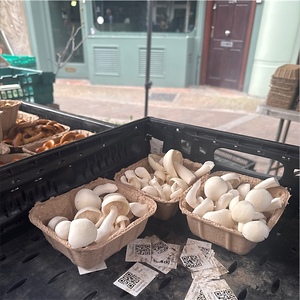


Tanba Shimeji Mushrooms
Estimated Inventory, lb : 0
Description/Taste
Tanba Shimeji mushrooms are small to medium in size and have rounded caps averaging 4-10 centimeters in diameter with semi-thick stems. When young, the caps are dark brown, and as they mature they lighten to buff-tan with a white ring around the edges. The caps are also smooth, convex, firm, and are moist, but not slimy. The white stem is spongy, averaging ten centimeters in length and two centimeters in diameter, and is dense and meaty. Tanba Shimeji mushrooms are chewy with a bitter taste when raw, but when cooked, they develop a tender, nutty, umami flavor and are mild with a hint of radish.
Seasons/Availability
Wild Tanba Shimeji mushrooms are available in the late autumn, while the cultivated versions are available year-round.
Current Facts
Tanba Shimeji mushrooms, botanically classified as Lyophyllum descartes, are a wild, edible variety that is also known as Hatake Shimeji mushrooms. Found in Japan growing in clusters on arable land, in deciduous and coniferous forests, and alongside roads and grasslands, the name Tanba Shimeji refers specifically to mushrooms growing in Japan’s Tanba province, a valley located to the north-west of Tokyo. This valley is very humid with extreme temperature differences between day and night, creating the perfect environment for the mushroom’s growth. Tanba Shimeji mushrooms are common in Asia and are used in soups, stews, and stir-fries.
Nutritional Value
Tanba Shimeji mushrooms contain vitamins B and D, potassium, copper, iron, and calcium.
Applications
Tanba Shimeji mushrooms are best suited for cooked applications such as frying, sautéing, braising, stewing, and roasting as their raw flavor tends to be unpalatably strong. They can be used in soups, bisques, stews, casseroles, omelets, noodle dishes, stir-fries, hot pot, rice dishes, and sauces. They also hold up well to deep-frying and can be made into tempura or are commonly stir-fried with butter and soy sauce. Tanba Shimeji mushrooms pair well with roasted meats, wild game, pork belly, poultry, seafood, bell pepper, potatoes, tomatoes, white wine, soy sauce, rice wine vinegar, miso, ginger, garlic, shallots, lemons, duck fat, leeks, tarragon, and rosemary. They will keep up to ten days when stored in a loose paper bag in the refrigerator.
Ethnic/Cultural Info
“Shimeji” is a broad Japanese term that refers to over twenty different fungi species that are found wild in Japan. The word “shimeji” roughly translates to “mushrooms that grow deep in the forest in the rainy season,” and wild Tanba Shimeji is regarded as common field mushrooms. Out of all the shimeji mushrooms, the hon shimeji is the most sought-after variety by chefs and home cooks, being regarded as the true shimeji mushroom, so the cultivation of the Tanba Shimeji is not widespread as many Japanese mushroom farmers prefer to grow hon shimejis.
Geography/History
Tanba Shimeji mushrooms are native to Japan, and the mushrooms found in supermarkets were likely cultivated by the biotechnology company, Takara Bio Inc. The shimeji mushroom has been difficult to breed and grow indoors on a large scale, but Takara Bio Inc has patented techniques for greenhouse-growing this finicky variety. Today Tanda Shimeji mushrooms can be found at select markets and stores in Japan.
Recipe Ideas
Recipes that include Tanba Shimeji Mushrooms. One
| Serious Eats |
|
Green Salad With Pickled Mushrooms, Cucumbers, Onions,and Pecorino |
Podcast








